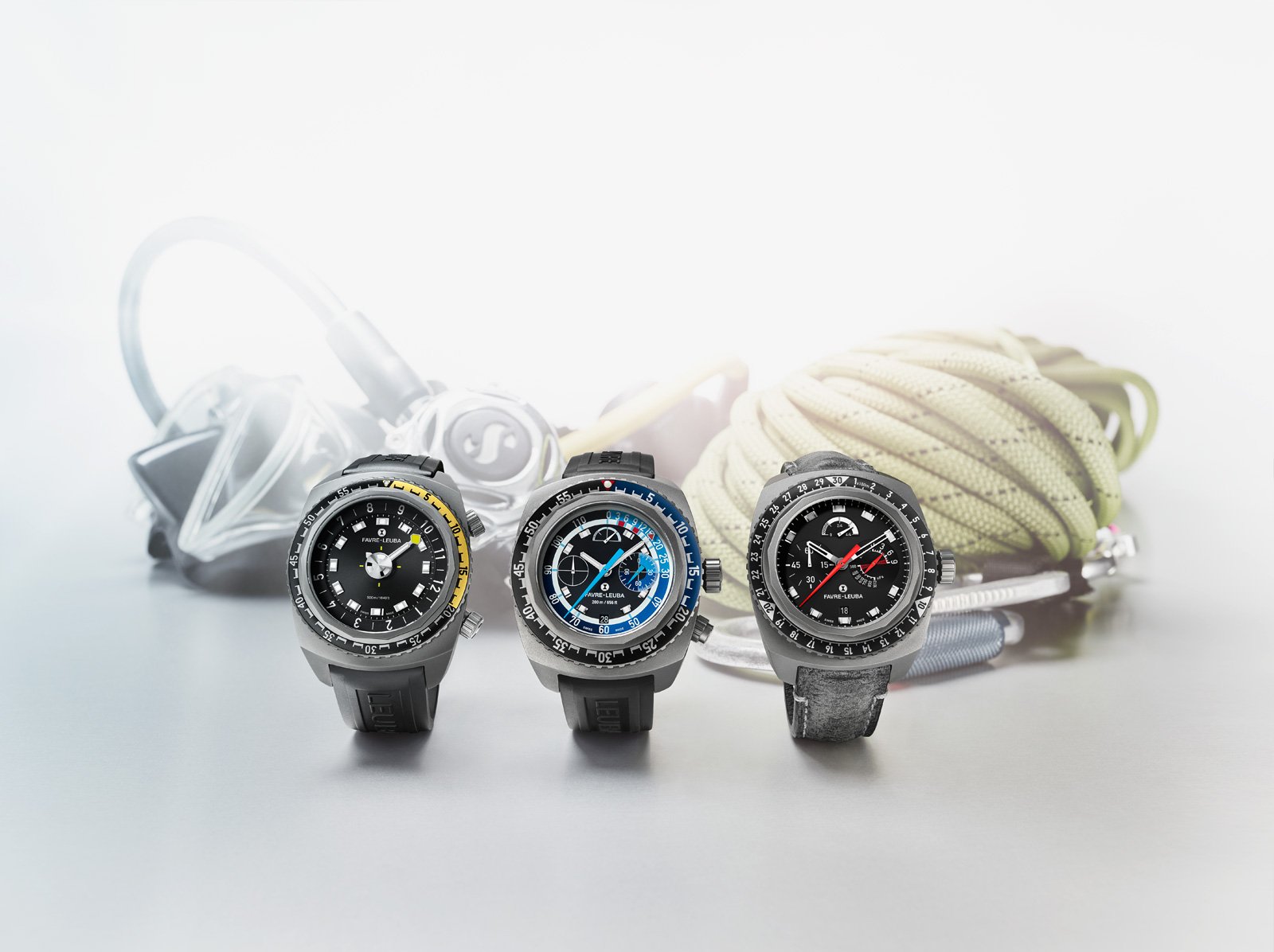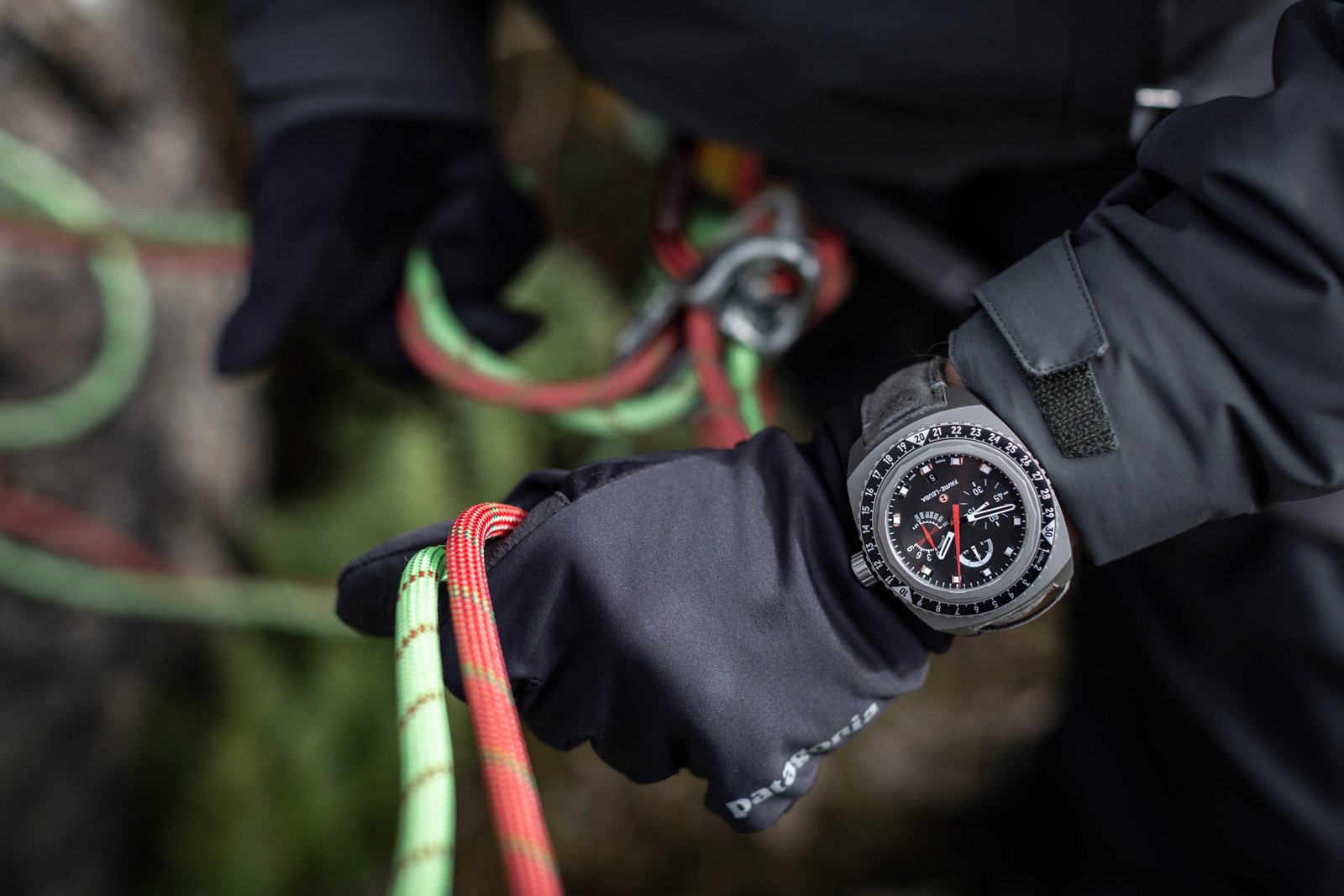he story actually begins in 1962, when Favre-Leuba showcased their Bivouac. It’s a world first. In that decade of triumph for the “instrument watch” the Bivouac, which has an altimeter and barometer function, marks a new milestone, and minds.
As we wrote in Europa Star in late 1962: “From now on, mountaineers, parachutists and pilots, to cite only a few examples, will be able to wear on their wrist, in plain view, the essential data they need”.

Reading this article, you get the impression that the Bivouac is for its time what the smartwatch is today. Far more practical than conventional altimeters, which are difficult to handle on icy, vertical rock faces, this model is also smaller, easy to consult on the wrist.
Tested by Swiss parachutists on terrain not far from Colombier army barracks near Neuchâtel, the watch is certain to render great service to ramblers, navigators and camping enthusiasts, states the article.
Mountaineer Michel Vaucher
Onto the wrists of mountaineers
In August 1964, two of the most experienced mountaineers of their time, the famous Italian climber Walter Bonatti (1930-2011) and Geneva-born Michel Vaucher (1936-2008, a great mountaineer and also a mathematician) attempted a climb that became legendary. Unconquered until then, the North face of the Whymper Peak – named after the first man to have reached the summit of the Matterhorn – rises to 4,208m and is challenging in the extreme. In 1964, no mountaineer has yet overcome the challenge. But the two men, with a Bivouac on their wrist, make the ascent in four days: four tense, difficult and exhausting days that Europa Star recounts in detail a few months later, in early 1965.
The ascent receives worldwide acclaim. It is even reported in one of our Japanese editions. And it is precisely a Japanese mountaineer, Junko Tabei, who becomes the first woman to reach the summit of Everest, in 1975, with a Bivouac by Favre-Leuba on her wrist.
-

- An original Bivouac. By using the rotating bezel – showing a scale up to 3,000m above sea level, so each division corresponds to 50m – and the central red hand, you can set the starting altitude and read it continuously during the ascent. The atmospheric pressure, in millibars, is read from a red pointer at the edge of the dial.
A very long story
But the story of Favre-Leuba is not confined to these four historic and dramatic days. It goes back much further, to 1718 to be exact, when Abraham Favre (1702-1790) started a watchmaking apprenticeship. He was officially appointed “Master Watchmaker” at Le Locle, in 1749. The brand takes its current name from the partnership set up in 1815 of the fourth generation of the Favre family with Auguste Leuba, originally from Buttes in Val-de-Travers. From then on, it enjoyed an impressive rise, winning prize after prize and tapping into new international markets, including India starting in 1865, which developed into an extremely important market for the brand.
-

- In 1950, as this ad published in the Asia edition of Europa Star shows, India was still one of Favre-Leuba’s largest markets. The brand enjoyed an excellent reputation there.
A pioneer of the instrument watch
After the end of World War II, Favre-Leuba rapidly succeeded in regaining its international status, notably by “leveraging its strong, very stable position in India”. It opened branches in Hamburg, London, Rangoon, Karachi, Singapore and New York.
From the mid-1950s, it enjoyed growing success in the then highly fashionable sector of instrument watches, not least with its marine watches Sea Chief, Sea King and Sea Raider, fitted with a new, in-house movement, the FL101, which gave rise to a whole series of calibres.
In 1960, Favre-Leuba introduced the Water Deep, the first genuine diving watch; then the Bivouac in 1962; then in 1968 the Bathy, the first mechanical watch to indicate diving depth, by means of a membrane system. In its heyday, Favre-Leuba sold more than 650,000 watches a year.
-

- The Bathy as readers discovered it in Europa Star in 1968.
- © Europa Star 1968
“Quartz crisis”
Favre-Leuba remained in the hands of its founding family until 1985. Then the advent of quartz dealt a fatal blow to the mechanical instrument watch and the owners were forced to sell out.
Troubled times ensued, the company passing from one hand to another. Among them, we can cite the American group Baccardi, the Benedom group (Martini & Rossi, Christian Dior Watches), the Jacques-Bénédict Time Force Group (Givenchy), then LVMH, who sold the brand in 2003 to the Spanish group Valfamily.
Enter Tata
It was not until 2011 that the brand, which had been dormant in the meantime, was bought by Titan, the big Indian watchmaking company owned by the powerful Tata group. At the time, a colleague at Le Temps wrote of a “transaction bordering the 2.5 million franc mark, according to documents supplied to the Bombay Stock Exchange”. But he adds that for that sum, “Titan has acquired only the rights to the brand. The company no longer had any production site.” Since then, the fate of Favre-Leuba has been in the hands of Titan. While development on the Indian market is one of its priorities, Titan, which has an international presence spanning 30 countries, intends to place Favre-Leuba at the pinnacle of its strategy.
Return to base camp

The new team is avidly digging into the company’s history and developing a strategy aimed at sustainability in the long term, which is also in phase with the growing interest in vintage instrument watches. The watches will be highly functional and equipped with exclusive in-house technology, their aesthetic value high. Swiss-made, developed and produced internally, they will represent the top range of the Titan group.
And, tradition oblige, the cornerstone of the collection will be the brand’s two legendary pillars: diving and mountaineering.
From heights to depths and everywhere in between

From left to right, the Raider Harpoon, Raider Bathy Memodepth and Raider Bivouac 9000
Click on the images to open a film in a new window:
Back to the Bivouac
Introduced in 2017, the Raider Bivouac 9000 – the direct descendant of the 1962 Bivouac – is the first watch to measure altitude up to 9,000m, an unprecedented achievement. Remember that the original Bivouac measured altitude up to 3,000m. But though revised and perfected from top to bottom, it still functions to the same principle developed more than 50 years ago, that of a built-in aneroid barometer. The principle itself is simple: a metal box in which a partial vacuum has been created, which expands or deflates depending on changes in atmospheric pressure. This is measured in hectoPascals (hPa).

The red central hand shows the altitude on a bi-directional rotating bezel with a scale divided into 50-meter increments up to 3,000m. A complete revolution by the red hand thus indicates an altitude of 3,000m. After 3,000m, the hand executes a second revolution up to 6,000m, then a third up to 9,000m.
This measurement is recorded on a small subdial at 3 o’clock. Its small, red, double-tipped hand shows on one side the number of revolutions currently in progress, from 0-9,000m (shown as 0, 3,6,9 x 1,000) and on the other, on a scale in hPa, the changes in atmospheric pressure at the altitude indicated on a scale from 1,013 to 300.

Powered by an FL311, hand-wound mechanical movement based on the EMC 3903M calibre, the Raider Bivouac 9000 has a power reserve of 65 hours. 48mm titanium case, rotating bezel with aluminium inserts, screwed crown, anti-reflective sapphire crystal, screwed bottom, waterproof to 30m Price: CHF 7,500.

The extremely legible Raider Bivouac 9000 is mounted on an ultra-hardwearing Velcro strap with a built-in RECCO® reflector. This technology was developed to facilitate the localisation of climbers buried under an avalanche and is used by numerous teams around the world.
The reflector works without using additional energy. A special detector with which rescue teams are equipped emits a directional radar signal which, when pointed in the direction of the reflector, is returned to the transmitter, indicating the position of the person being searched for. The returned signal gains power the closer you get to the victim.
The adventure continues
The Bivouac is now renewing its links with the great mountaineering adventure. Since 1964 and the spectacular ascent of the Whymper Peak, after which Vaucher and Bonatti declared that it would “remain unique and that this North face would never again be conquered”, all mountaineering boundaries have been pushed back. You only have to look at the numerous routes opened on this famous North face, as shown in the illustration below.
-

- The different routes opened on the Grandes Jorasses (document: camptocamp.org).
But the Raider Bivouac 9000 is still, more than ever, the preferred instrument watch of the greatest mountaineers. “Even in the most extreme conditions, my Raider Bivouac 9000 performed its essential functions flawlessly,” the American Adrian Ballinger recently declared after his ascent of Everest in May 2018, in temperatures of -40C. For his Swiss colleague, climber Nicolas Hojac, “the huge advantage of my Raider Bivouac 9000 is that it tells me how far away the summit is, even after the batteries of the electronic instruments have failed”.
-

- Mountaineers Nicolas Hojac and Adrian Ballinger


































































